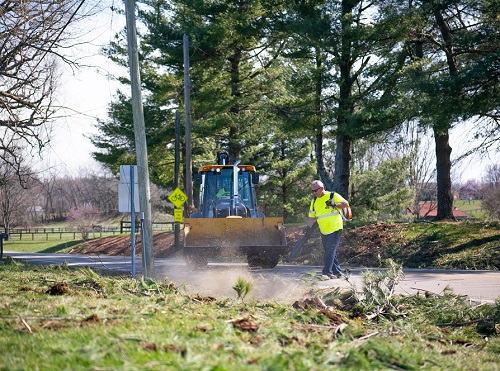The Kentucky Transportation Cabinet is cranking up its weed control program to keep a dozen unwanted and noxious weeds from encroaching on the bluegrass state’s transportation infrastructure.
[Above photo by KYTC]
Weeds are more than a gardening nuisance; they can obscure sightlines, compromise drainage, wipe out native plantings, and kill off roadside turf, leading to roadbed erosion and serious maintenance issues.
“Some weeds are highly destructive and difficult to control,” said Naitore Djigbenou, executive director of the KYTC Office of Public Affairs.
“Weeds clog storm-water drainage systems and can compromise pavement and structures which can lead to potholes and structures failures,” Djigbenou noted, which is why KYTC uses Integrated Roadside Vegetation Management or IRVM to “suppress and control noxious and invasive weeds on state-maintained highways.”
Weed control is accomplished through mowing, turf-grass establishment, insect biological control, and the use of herbicides approved by the Environmental Protection Agency that are applied by licensed applicators.
“If left untreated, some weeds can grow several feet tall and impact driver visibility,” KYTC Secretary Jim Gray pointed out in a recent news release. “Actively treating the weeds on state-maintained property enhances safety, prevents damage to ditches and drains and minimizes the presence of plants that attract deer near highways,”
The agency also reaches out to private landowners, he said, encouraging them to request that highway crews treat some noxious weeds on adjacent state-owned right-of-way.
Kentucky law dictates which 12 plants are considered “noxious weeds” that should be eradicated. They are Amur Honeysuckle, Canada Thistle, Common Teasel, Cutleaf Teasel, Japanese Knotweed, Johnsongrass, Kudzu, Marestail, Multiflora Rose, Nodding Thistle, Poison Hemlock, and Spotted Knapweed.
Noxious weeds often invade and destroy the roadside turf grass, leaving those areas vulnerable to erosion, KYTC added. They can also smother native plants through rapid reproduction and long-term persistence. Twenty years ago, the Federal Highway Administration published a compendium of resources aimed at removing invasive species of plants that might take root along roadways nationwide. They can cause “significant changes” to local ecosystems, upsetting ecological balances and causing economic harm to the country’s agricultural and recreational sectors.


